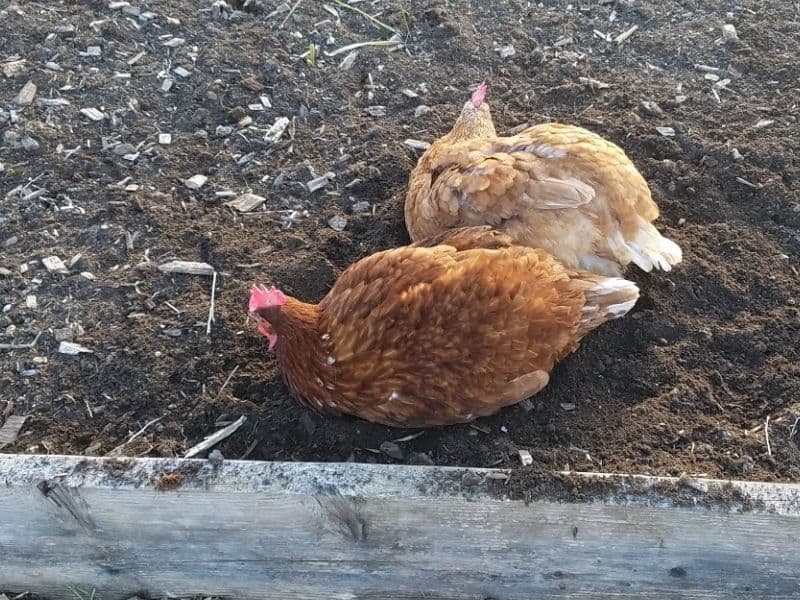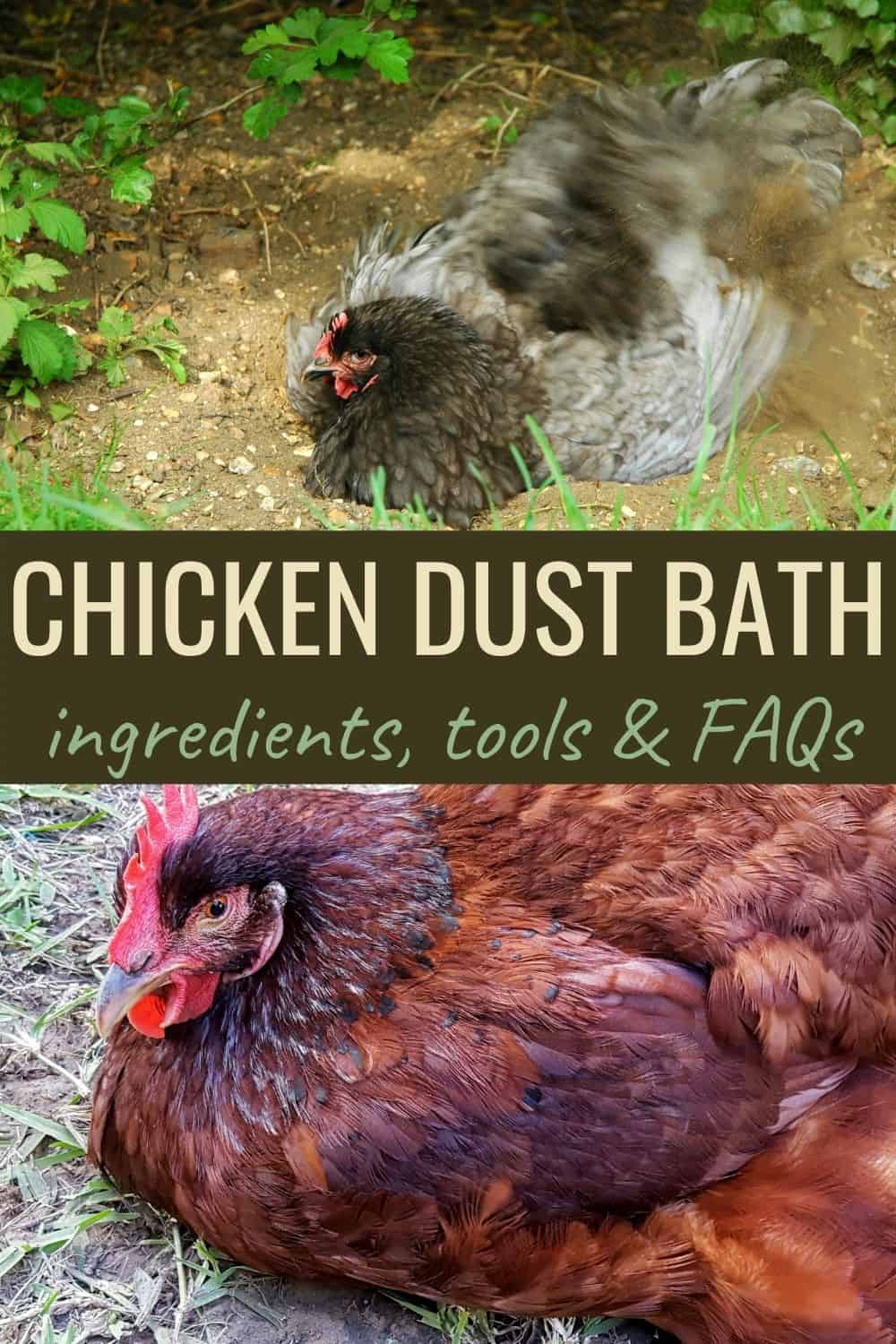Dust baths are important for chickens because they help them get rid of parasites, remove excess oils from their feathers, and maintain the health of their skin. They also provide relief from stress and boredom. But what exactly is a chicken dust bath and how do you make one for your birds?

Keeping Chickens Healthy With Dust Bathing
First-time chicken keepers read a lot about how to feed, water, and protect their birds. What they don’t read about as much is the quality of life stuff their chickens really want, like dust bathing!
I didn’t know a thing about dust bathing until my first set of girls started flopping all over my mulch beds! Worried they were sick, I franticly googled their behavior, only to discover they were perfectly normal. You learn a lot with your first chicks!
What exactly is a chicken dust bath? Think of a human shower, only dustier, and with less water. Dust baths are necessary to keep your girls happy and healthy, removing feather oils, foul smells, and any mites or lice that could be crawling around on their bodies.
Dust bathing takes up to half an hour and involves flapping, cackling, and lots of happy clucking from your chickens. If you’ve never seen it happen before, boy are you in for a treat!
If chickens aren’t given a dust bathing spot, they will make their own. Free-range chickens target landscaped or mulched areas, while caged chickens usually attempt to create dust ‘bowls’ in sunny places.
Lots of beginners want to know how to make a dust bath and ingredients from scratch. Here’s a great way to DIY the whole project from the ground up.
How To Make A DIY Chicken Dust Bath
Chicken dust bath recipe
Dirt alone isn’t really enough for chickens, which is why you should throw in some additional ingredients to keep your ladies happy. Here’s my favorite chicken dust bath mix:
- Sand for scratching those hard-to-reach places.
- Sulfur dust to get rid of any mites or lice that could be hiding around on your birds. Not only is it a more pesticide-free option, but it has been scientifically proven to get the job done. You can also use Diatomaceous Earth (DE), which I adore, although not everyone feels comfortable giving this to their chickens. It’s really up to you.
- Dry soil – this one’s a no-brainer, huh? Where I’m from, the native dirt is all clay and not very easy to crumble. If you are in this situation as well, you may want to purchase some topsoil.
- If you have access to wood ash, add some of it to the chicken dust bath: it helps keep parasites away.
- Now, if you want to really spoil your girls, add some dried herbs to their dust bath. Dried lavender, mint, thyme, rosemary, or lemon balm are great and usually plentiful in your garden (how to grow lavender)
If you want to get fancy, other chicken lovers suggest using peat moss to lessen the effects of moisture and compaction. However, this is an additional luxury for your ladies. Manually breaking up and changing out ingredients regularly is probably going to be your best bet.
Chicken dust bath containers
While chicken can bathe anywhere there’s a patch of fluffy dust, you might want to make a designated dust bathing area. If so, you can use any of these containers:
- kiddy pool (I like a hard plastic one like this one)
- a box made from wood planks (an old raised bed works too)
- a plastic tub from Walmart
- old tires (if you only have a few birds)
How to make a chicken dust bath
Not everyone keeps free-range chickens that take dust baths on their own. In fact, most beginning chicken keepers keep their ladies in a coop! Thankfully, it doesn’t take much to DIY your very own chicken dust bath, even inside a run. With the right ingredients, this project can take as little as five minutes. Of course, if you want to be fancy, it can take a lot longer, depending on the complexity you’re going for.
Materials needed
- Wood, a kiddie pool, or a strong plastic tub
- Your chicken dust bath ingredients (at least dirt, sand, and sulfur dust/DE)
- A hand shovel or small garden rake
- If you are planning on building a wooden box with a lid, you’ll need a hammer, nails, and hinges
1. Decide how you want your dust bath to look
If you have free-range chickens, you might just want to dig a hole in the ground or throw the mixed bath ingredients near a place they already bathe. For coop chickens, you can take your pick of the containers listed above.
Plastic containers might need holes cut into the side to allow traffic inside and out. Kiddie pools accommodate a much larger number of chickens while also being easy to clean.
For added curb appeal, construct a small box or square ‘sandpit’ area for the birds to play in. Think of it as a sandbox for children, but instead filled with cute, fluffy birds.
2. Pour out a layer of the above mix that is no more than a few inches deep
You want to make sure that the poor girls won’t drown!
For free-range chickens, scatter the mix on the ground, dump it into a pit, or lay it on the grass. Your girls will go gaga!
For coop chickens, place the mixed ingredients into a prepared container, dragging it into a place your girls are likely to notice. Just don’t put it under their roost! Trust me.
3. Cover the dust bath box if rain is in the forecast
Chickens love dust, not mud, so you won’t find them hopping into puddles unless you happen to own some playful birds. Keeping your dust bath clean and dry will be an important factor moving forward.
Is rain on the way? If you built a box, cover up your dust bath with its lid. Put a cover on your plastic tub, or stretch a tarp over your kiddie pool.
Learn more about raising chickens.
Chicken dust bathing FAQ
What is a dust bath?
A chicken taking a dust bath may look a little scary to first-timers, but it’s simply behavior in which the birds coat their bodies in dust. Dust baths are often taken in a tub, hole, box, or another container if given enough space and the right ingredients. If you have Guinea Hens or a similar species of fowl, you’ll probably notice them engaging in this behavior, too.
Why do chickens need a dust bath?
Chicken dust baths help our egg-laying companions cleanse their bodies. Regular dust bathing reduces oils on their feathers. It also scrapes off any parasites that could be hiding in their down or around their skin. Dust bathing is also an important social behavior, which is why you’ll sometimes see groups of your hens taking baths together.
Do chicken dust baths have to be in a container?
Nope! Chickens might be picky sometimes, but they definitely aren’t picky about their dust baths. You can dig a hole right into the ground to get started, or just fill up a kiddie pool in the steps described above. Just make sure that you replenish or clean out the bath after enough use. After all, nobody wants to get into the tub after the 100th sweaty shower, right?
Is all dirt good for a chicken dust bath?
Most dirt will work, but it’s always nice if you have crumbly, loose soil that’s easily able to be thrown around, and get in between the girl’s feathers. Add a few of the ingredients in the recipe section above, and you’ll have a happy flock of birds.




Golden Comet Chickens - What You Need To Know Before Getting Yours
Monday 27th of March 2023
[…] plenty of water, shade in hot weather, and protection from predators. Providing the chickens a place to dust bathe can prevent lice and mite […]
What Is Marek’s Disease In Chickens
Monday 26th of April 2021
[…] Chicken dust bath: ingredients, tools, and FAQs […]